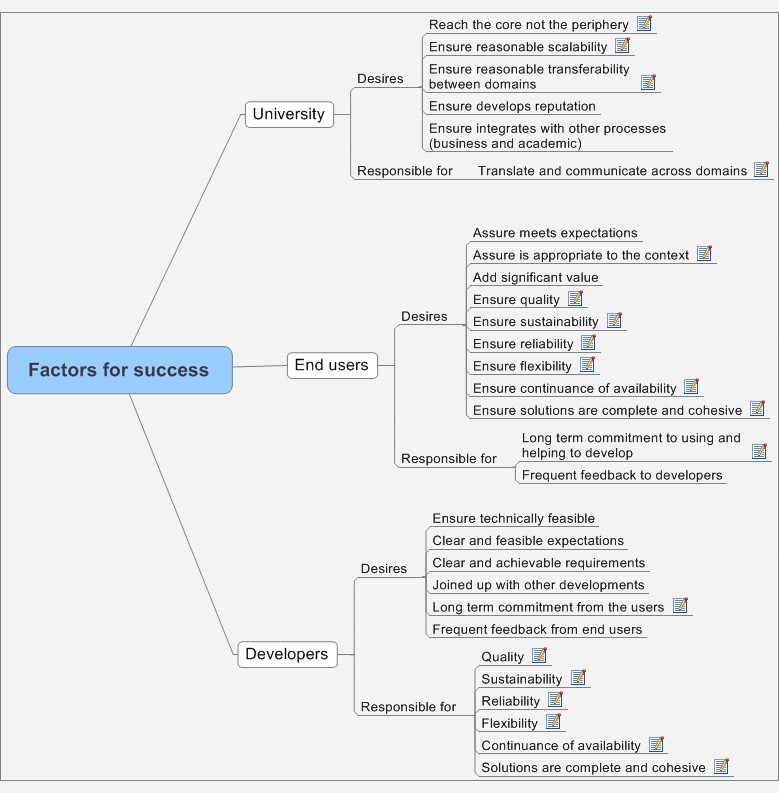E–learning Research: Factors for choosing e–learning projects
Follow-up to E–learning Research: Achieving success in e–learning development from Transversality - Robert O'Toole
I am therefore seeking:
- guidelines on selecting projects, such that those chosen are more significant and continually successful;
- means for encouraging the formation and completion of projects (by staff and students) that meet those criteria.
My first conjecture is that a successful e–learning development project requires at least the cooperative endeavours of IT providers (including development and support), the University (that is, services and interests that are global to the whole institution), and the end users (the staff and students who will be affected by the development, and who play a central role in making it happen, usually as part of the project team).
Each of these parties has a set of desires that make the development feasible and worthwhile. In return they have certain responsibilities that must be met for their own desires or those of others are to be met (and hence for the development to be successful). These desires and responsibilities form the factors that contribute to the success of a development. I am trying to create a comprehensive account of these factors. Here is the concept map node so far:

It should be immediately apparent that for all of this to be assured (rather than merely accidental), there needs to be a cooperation of the efforts and interests of the many people involved. At this point we should note that some people do believe that we simply should not worry about this problem. Coordination of all of these people and factors at the same time being too difficult. Rather, we should just stand back and allow new practices to emerge from a diverse network of people all innovating with the available toolset, and actively feeding new requirements to the IT providers and the University. The idea is that the near–viral force of "network effect" will result in positive change over time. This may indeed sometimes be true, and certainly is when countenanced on a very large scale (e.g. the whole internet). But within a University there just are not enough users with enough time and desire to innovate. Furthermore, demands on the time of core users (those who can assure that a new approach is permanently adopted) are so great as to prevent deeper innovation, affecting and improving core activities. Consequently innovation and innovators tend to be peripheral, thus failing on desire 1.1.1.1. Note that although there may be small and quite visible innovations, transferable across domains (1.1.1.3), they are not significant innovations and do not add significant value (1.2.1.3). I conclude then that deeper more widespread cooperation is essential for significant and cost–effective development (the Learning Grid was planned, many cooperated on it, it did not emerge out of the chaos).
(Note on strategy for Rob Johnson: a successful guerrilla operation is only achievable through the deployment of large numbers of operatives, each with plenty of time and committment. That is what distinguishes guerrilla war from terrorism).
Consistent and ongoing commitments are absolutely necessary, as is good communication. The big question concerns how to assure that this happens (problem 2 stated above). The common solution is to form projects that have their own strong distinct identity, and which unite the various partners. How can I do this?
My single greatest problem is in getting sufficiently consistent committment from end users, including staff and students, especially those who are core project members. If success is to be achieved through effective projects, then I must find a way of forming good projects that meet the list of factors for success. I shall now work on this question.
 Robert O'Toole
Robert O'Toole

Chris May
how are you defining "successful" ?
05 Apr 2006, 13:27
Robert O'Toole
From an earlier entry:
"I define the goal quite simply: the adoption of good new technologies by lecturers and students to enhance the teaching and learning process (which at Warwick includes research activities). The effort in adopting the new technologies should be justified by the value that they add, and not negated by any disruption that they introduce to existing practices. The end result should be to contribute to Warwick becoming a world class university."
You could interpret that as meaning that I would like to see, as common practice here, the use of the best available and most appropriate learning technologies. Isn't that what a top university should be like?
Success of course also comes in differing degrees along the twin axis of:
For example, to see a group of staff and students collaborating in the online production of a glossary, as a core part of the research-based learning process, would be a deeper and more significant advance than simply getting departmental prospectuses copied into web pages. To get a large number of students adopting that approach would be event more significant, on both axis of measurement. However, it is quite easy to add value through changes adopted by many people to a very shallow extent, or by a few to a deeper extent (without transferability), and that is what tends to happen (easy wins, good statistics).
Success then would be the adoption within the core academic activities of many people of learning technologies that significantly enhance their work.
05 Apr 2006, 15:51
Robert O'Toole
Also notice the shift in that response from "e-learning" to "learning technology".
05 Apr 2006, 15:52
Add a comment
You are not allowed to comment on this entry as it has restricted commenting permissions.